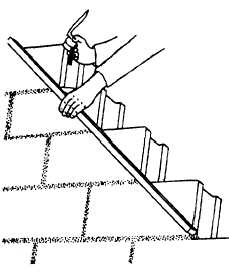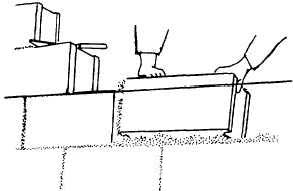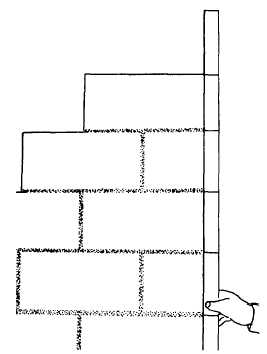(view 4). Make the joints 3/8 inch thick. Then, place each block in its final position, and push the block down vertically into the mortar bed and against the previously laid block. This ensures a well-tilled vertical mortar joint (view 5). After laying three or four blocks, use a mason’s level as a straightedge to check correct block alignment (figure 8-8, view 1). Then, use the level to bring the blocks to proper grade and plumb by tapping with a trowel handle as shown in view 2. Always lay out the first course of concrete masonry carefully and make sure that you properly align, level, and plumb it. This assures that succeeding courses and the final wall are both straight and true.
The fourth step is to build up the corners of the wall, usually four or five courses high. This is also called laying up a lead. Step back each course one-half block. For the horizontal joints, apply mortar only to the tops of the blocks already laid. For the vertical joints, you can apply mortar either to the ends of the new block or the end of the block previously laid, or both, to ensure well-filled joints (figure 8-9). As you lay each course at the corner, check the course with a level for alignment (figure 8-10, view 1), for level (view 2), and for

Figure 8-12.-Checking horizontal block spacing.
plumb (view 3). Carefully check each block with a level or straightedge to make sure that all the block faces are in the same plane. This ensures true, straight walls. A story or course pole, which is a board with markings 8 inches apart (figure 8-11), helps accurately place each masonry course. Also check the horizontal block spacing by placing a level diagonally across the corners of the blocks (figure 8-12).
When filling in the wall between the corners, first stretch a mason’s line along the extensor block edges from corner to corner for each course. Then lay the top outside edge of each new block to this line (figure 8-13). How you grip a block before laying is

Figure 8-11.-Using a story or course pole.

Figure 8-13.-Filling in the wall between corners.
Continue Reading